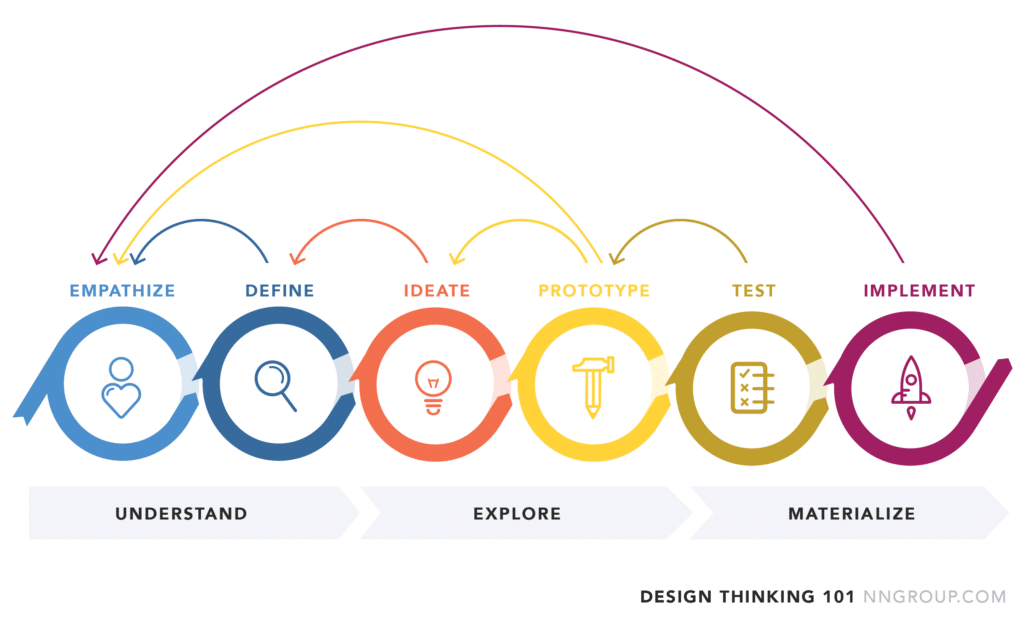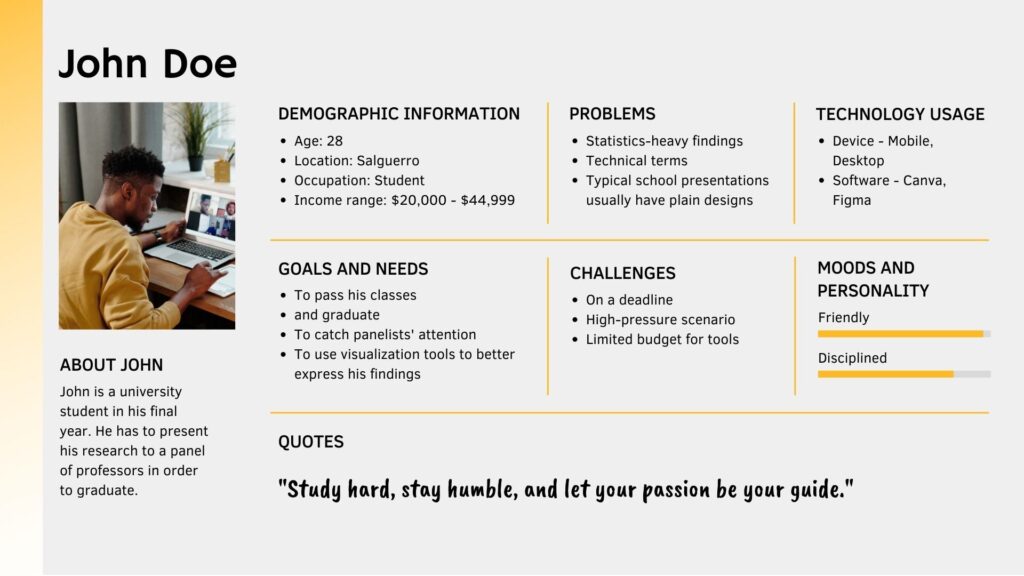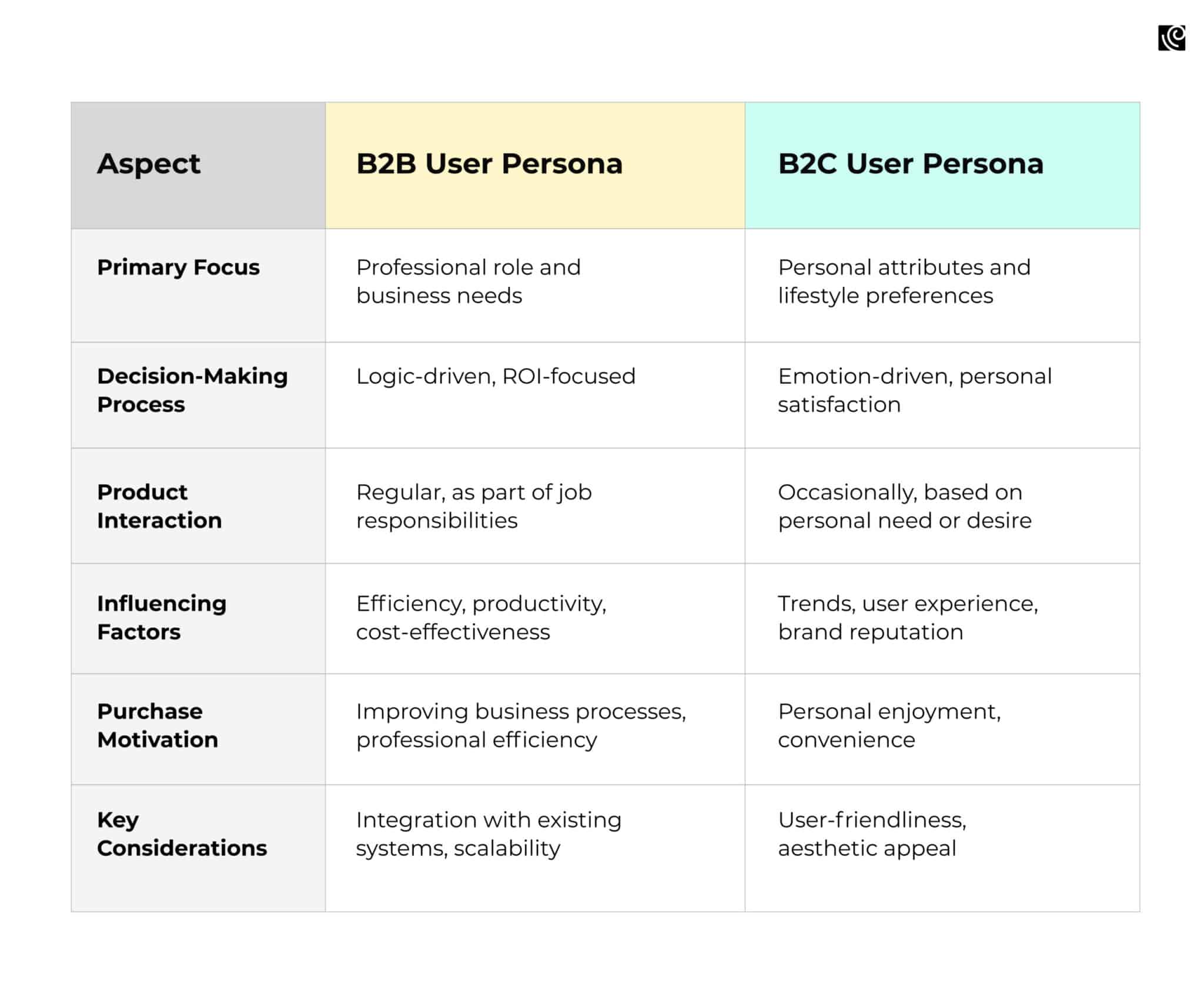Picture this: You’re a stakeholder in a company specializing in enterprise SaaS solutions, and your team is embarking on developing a new product. The challenge? Understanding the diverse needs of your potential users. Imagine there are ten different types of users who will interact with your product, each with unique goals and ways of using the interface. This scenario isn’t just a thought exercise—it’s a common situation in industries like healthcare, B2B, especially companiess with digital products
This is where the concept of UX user personas in UX/UI design becomes invaluable, even if you’re not a designer yourself. UX User personas are like detailed maps that guide the development of a product to meet specific user needs. They are created through extensive user research and represent the various target users for whom the product is being designed.
This approach not only enhances the usability of the product but also aligns its development with the real-world requirements of its users, making it more likely to succeed in the market.
Understanding UX User Personas
UX User personas are the linchpins in the realm of user experience (UX) design and product management, particularly in user-centered design.
They represent fictional characters, but are grounded in the realities of your target audience, created through meticulous user research. Think of them as detailed archetypes that encapsulate the needs, goals, and behaviors of potential users.
For example, in a healthcare SaaS product, one persona might be ‘Doctor,’ who needs quick access to patient records, while another could be ‘Administrator,’ who requires efficient data processing tools.
By understanding these personas, your team can develop a product that caters to each user’s needs, ensuring a more successful and user-centered design.
This persona helps in focusing the design and development efforts to address specific user requirements, ensuring the product is tailored to its end users.
In UX design thinking, these personas guide every stage of the product development cycle, from conception to launch. They are not just a part of the creative process but are pivotal in making design decisions that resonate with the target audience.
The Process of Creating User Personas
Creating UX user personas is a fundamental step in UX design and product management, acting as a key to unlocking user-centric solutions. Here’s a step-by-step guide:

Gather User Research: Start by collecting data through methods like surveys, interviews, and field observations. This forms the basis of your personas, ensuring they are rooted in real user data.
Identify Behavioral Patterns: Analyze the research to spot common behaviors, needs, and goals among your users. This helps in segmenting the user base into distinct groups.
Create Draft Personas: Draft personas based on the patterns identified. Each persona should represent a significant user segment. For example, in a healthcare SaaS company, you might have ‘Clinician’ who prioritizes efficiency, and ‘Administrator’ who focuses on data accuracy.
Detail the Personas: Flesh out each persona with specific details like demographics, goals, frustrations, and typical scenarios they encounter. This helps in making the persona more relatable and realistic.
Validate and Refine: Share the personas with stakeholders and refine them based on feedback. It’s crucial that personas accurately reflect the users to guide effective design decisions.
Implement in Design Process: Use these personas throughout the UX design process to ensure user-centric decision-making
User Persona Template
A UX user persona template might include sections like background, demographics, goals, challenges, and preferred interaction with the product. By following these steps, you create a valuable tool that guides user-centered design, resonating with the needs and preferences of your actual user base. Here’s a generic template to get you started:

Identifying UX User Personas for Enterprise Applications

Special considerations for enterprise UX personas are crucial due to the unique context and demands of the business environment. When designing personas for enterprise applications, here are some key aspects to keep in mind:
- Role-Specific Needs: Enterprise personas often represent users with specific job roles. Their needs are closely tied to their professional responsibilities and the tasks they perform. Understanding these roles in detail is crucial for creating personas that accurately reflect user requirements in a business setting.
- Complex Decision-Making Processes: In an enterprise context, the decision-making process for using or purchasing a product is usually complex, involving multiple stakeholders. It’s important to consider not just the end-users but also the decision-makers who may have different priorities and concerns.
- Integration and Compatibility: Enterprise solutions often need to integrate with existing systems. Personas should reflect the user’s proficiency with these systems and any potential challenges they might face with integration.
- Security and Compliance: For enterprise users, issues like data security, privacy, and regulatory compliance are often top priorities. Personas should include attitudes and requirements related to these aspects.
- Training and Support: These personas often require detailed information on the level of training and support needed. This can range from onboarding new software to ongoing technical support.
- ROI and Efficiency: Enterprise users are typically focused on return on investment (ROI) and efficiency gains. The personas should reflect how the product can contribute to these outcomes.
- Collaborative Features: Many enterprise solutions are used in collaborative environments. Understanding how personas interact with others in the workspace, and what tools they need to collaborate effectively, is important.
- Customization and Personalization: The ability to customize and personalize the user experience to suit different roles within an organization is often a key requirement for enterprise users.
- Long-Term Engagement: Enterprise personas often require a long-term engagement with the product, considering not just the immediate usability but also long-term maintenance, updates, and evolution of the product.
Incorporating these considerations ensures that the personas developed for enterprise applications are realistic, comprehensive, and directly relevant to the complex needs of business users.
UX User Personas: B2B Vs B2C
For enterprise UX personas (B2B), the focus is often on the functional role, job responsibilities, and the organizational goals of the users. In contrast, B2C user personas typically concentrate on personal characteristics, lifestyle, and individual preferences.
Here’s a table highlighting key differences:

This distinction is critical when designing UX user personas for enterprise applications. The goal is to develop a deep understanding of user needs and behaviors within their specific contexts—whether it’s a business environment or a personal setting.
Common Pitfalls in UX User Persona Creation and How to Avoid Them

In the realm of persona creation for UX design, there are common pitfalls that can hinder the effectiveness of the personas. Here’s a summary of these pitfalls, along with tips to avoid them:
Pitfall #1: Wrong Goal
How to Avoid: Always start with clear objectives for your personas. Understand why you need them and how they’ll be used in your project. They should be more than just generalized portraits; they should serve as tools for understanding your target audience’s specific needs and goals.
Pitfall #2: Treating Personas as One-Size-Fits-All
How to Avoid: Recognize that one persona cannot cover all aspects of your business. Create different personas for different products or business levels, each tailored to the specific audience segment it represents.
Pitfall #3: Choosing the Wrong Segmentation Type
How to Avoid: Select a segmentation approach that aligns with your goals. Options include marketing segmentation (demographics, consumer behavior), behavioral attributes (needs, goals, pain points), or jobs-to-be-done segmentation (desired outcomes, better life descriptions). The choice should be driven by your specific context and objectives.
Pitfall #4: Intent to Create a Perfect Persona Immediately
How to Avoid: Start with a proto-persona based on initial assumptions, then refine it over time through research and feedback. This approach allows for flexibility and iterative improvements.
Pitfall #5: Using One Format for All Persona Profiles
How to Avoid: Adapt the persona format to suit your current needs. It’s okay to have multiple versions of the same persona for different purposes, such as detailed versions for team discussions and simplified ones for presentations.
Pitfall #6: Viewing Persona Creation as the Final Goal
How to Avoid: Remember that creating personas is just the beginning. Use them actively in your product development process, for brainstorming, planning, and guiding decisions. They should be integral to building customer journey maps and other UX strategies.
By being mindful of these pitfalls and applying the corresponding tips, you can create more effective and realistic personas that truly benefit your UX design and product management efforts. This approach ensures that personas are not just theoretical constructs, but practical tools that contribute to a deeper understanding of your users and guide your product development in a meaningful way.
User Research and UX User Personas
User research is an indispensable component in the creation of UX user personas, serving as the foundation for user-centered design. This research helps in understanding the needs, behaviors, and motivations of potential users, ensuring that the resulting personas accurately reflect the target audience.
Methods of Conducting User Research

- Surveys and Questionnaires: These are effective for gathering quantitative data from a large audience. They can provide insights into demographics, preferences, and usage patterns.
- Interviews: One-on-one interviews offer qualitative insights. They allow for in-depth exploration of user attitudes, experiences, and motivations.
- Observational Studies: Observing users in their natural environment can uncover how they interact with products or services, revealing unarticulated needs and behaviors.
- Usability Testing: This involves users interacting with a product or prototype, providing insights into user experience and potential pain points.
- Analytics and Data Analysis: Reviewing data from website analytics, CRM systems, and other digital tools helps understand how users interact with existing products or services.
- Social Media and Forum Analysis: Monitoring discussions on social media and forums can reveal users’ opinions and discussions about products, services, or brands.
Using Research Data to Create Personas
After gathering data, the next step is synthesizing this information to create UX user personas. This process includes:
- Identifying Patterns: Look for common behaviors, goals, and challenges among the data.
- Segmentation: Divide your audience into distinct groups based on these patterns.
- Persona Development: For each segment, create a detailed persona. This should include demographics, goals, motivations, frustrations, technology usage, and any other relevant characteristics.
- Refinement: Validate and refine personas with additional research or stakeholder feedback.
By integrating these methods, user research becomes the cornerstone of creating effective and realistic personas. These personas then guide the design process, ensuring that products or services are tailored to meet the specific needs of the target audience.
User Personas in Different Contexts
UX User personas play a pivotal role in various fields, especially in product management, UX design, and UI design. Each field utilizes personas differently to enhance user experience and product effectiveness. Here’s a quick summary of how different fields use UX user personas.

In all these fields, user personas serve as a bridge between the user and the product team, ensuring that the end product aligns with user needs and expectations. They are a fundamental tool in creating user-centered designs that not only meet functional requirements but also enhance the overall user experience. Let’s take a brief look at each of these fields.
1. Product Management
In product management, user personas are instrumental in guiding product development and strategy. They help product managers understand who the users are, what they need, and how the product can solve their problems. This understanding is crucial for prioritizing features, making strategic decisions, and communicating the product’s value proposition. For example, a ‘Product Manager Persona’ might focus on key aspects like market trends, user feedback, and competitive analysis to guide the development of a product that meets market demands and user needs.
2. UX Design
In UX design, user personas are used to create products that are not only functional but also provide a delightful user experience. They inform the design process, ensuring that user needs and behaviors are at the forefront of every design decision. This includes aspects such as usability, accessibility, and the overall user journey. A ‘UX Designer Persona’ might focus on how users interact with a product, their motivations for using it, and the challenges they face, leading to a design that is both intuitive and user-friendly.
3. UI Design
For UI designers, UX user personas help in creating interfaces that are aesthetically pleasing and resonate with the target audience. Understanding the user’s preferences, limitations, and expectations allows designers to craft interfaces that are not only visually appealing but also easy to navigate. A ‘UI Designer Persona’ might concentrate on visual elements like layout, color schemes, and typography, ensuring that the interface appeals to the user’s tastes and preferences.
UX User Personas in Design Thinking

UX User personas play a crucial role in design thinking processes, greatly contributing to the user-centered design approach. Here are the key ways in which they are integrated:
- Empathy Building: UX User personas help in developing empathy among the design team. By presenting user stories and backgrounds, they allow designers to put themselves in the users’ shoes, understanding their needs, challenges, and experiences.
- Defining the Problem: In design thinking, clearly defining the problem is essential. UX User personas provide a focused perspective on what the real issues are from the user’s point of view, guiding the problem-definition phase.
- Ideation: During brainstorming sessions, personas serve as reference points. Ideas can be generated and evaluated based on how well they address the needs and pain points of the personas.
- Prototyping: When creating prototypes, UX user personas ensure that designs are tailored to real user needs and behaviors, leading to more effective solutions.
- Testing and Feedback: UX User personas guide the testing process by representing the types of users who will be giving feedback. This ensures that feedback is relevant and can be used to make meaningful improvements.
- Guiding Decision Making: Throughout the design thinking process, personas help keep the focus on the user, ensuring that every decision made contributes to a better user experience.
- Avoiding Assumptions: Personas, being based on research, help in reducing assumptions about users. This leads to solutions that are more aligned with actual user needs rather than perceived ones.
- Communication Tool: Personas are effective communication tools, helping diverse teams understand and remember user needs and characteristics, fostering a shared understanding and vision.
- Enhancing User-Centered Design: By centering the design process around detailed representations of target users, personas make the design process inherently user-centric.
- Long-term Strategy: Personas can guide long-term strategy by providing a stable understanding of the target users, which can be referred to in future projects.
In essence, UX user personas are integral to design thinking, providing a human-centered approach that ensures solutions are not only innovative but also deeply relevant to the users they are designed for.
Best Practices for Persona Creation in User Experience Research

- Diversify Data Sources: Use a mix of qualitative and quantitative data from various sources like surveys, interviews, and analytics to create a well-rounded persona.
- Involve Stakeholders: Engage different stakeholders, including marketing, sales, and customer service teams, to gain a comprehensive view of the user.
- Use Real Quotes and Stories: Incorporate actual quotes and stories from user research to make personas more relatable and vivid.
- Focus on Motivations and Goals: Prioritize understanding the user’s underlying motivations and goals rather than just their superficial characteristics.
- Avoid Stereotyping: Ensure that personas are based on research data to avoid falling into stereotypes, which can lead to biased design decisions.
- Validate and Iterate: Regularly validate personas with actual users and stakeholders, and be open to revising them as needed.
How to Keep UX User Personas Updated and Relevant

- Regular Review Cycles: Set periodic reviews for personas to ensure they remain aligned with the current user base and market trends.
- Monitor User Feedback and Trends: Continuously gather and incorporate user feedback, and stay abreast of industry trends that might affect user needs and behaviors.
- Incorporate Usage Data: Use product usage data to refine and update personas, especially in terms of technology preferences and usage patterns.
- Align with Business Goals: Regularly align personas with evolving business goals and strategies to ensure they remain relevant to the organization’s objectives.
- Educate the Team: Keep the team informed about any updates to personas and ensure that everyone understands their importance and how to use them effectively.
In Summary
The creation and application of UX user personas are vital in shaping user-centered design and product strategies. The insights garnered from well-crafted personas not only guide design thinking processes but also empower product management and UX/UI design decisions. If you’re looking to delve deeper and create impactful personas, Koru UX offers comprehensive UX research services.
Our expertise in user research provides the foundation for understanding your audience, ensuring that every design decision is informed and effective. Unlock the full potential of UX user personas, transforming user insights into compelling design solutions that resonate with your target audience. Contact our design experts for more.









